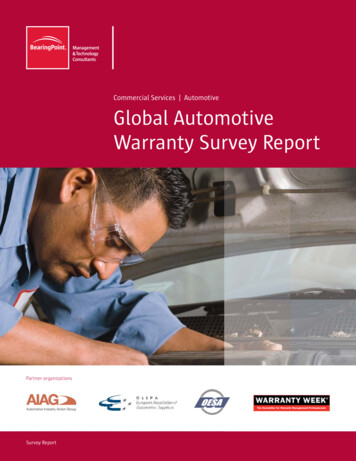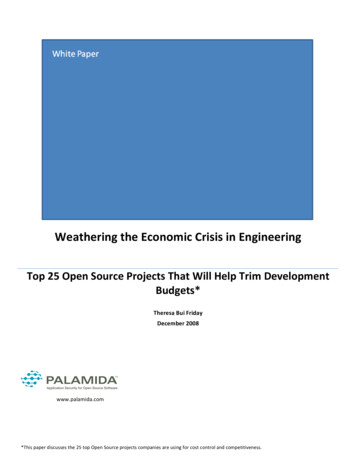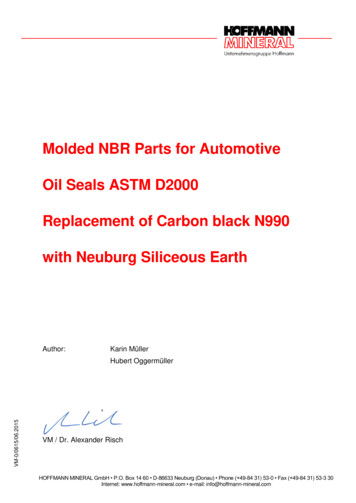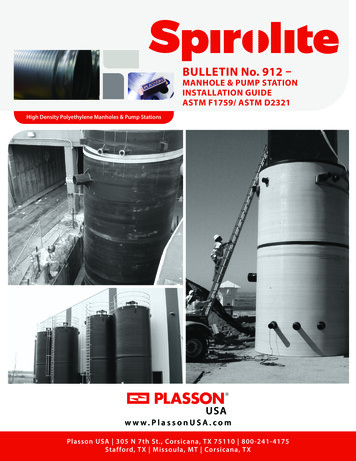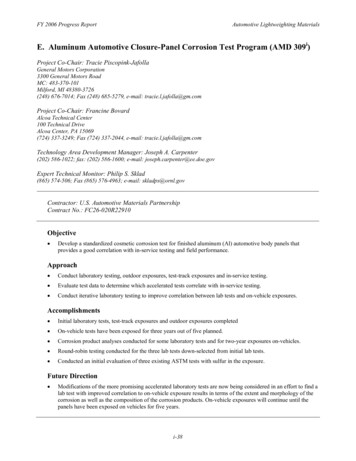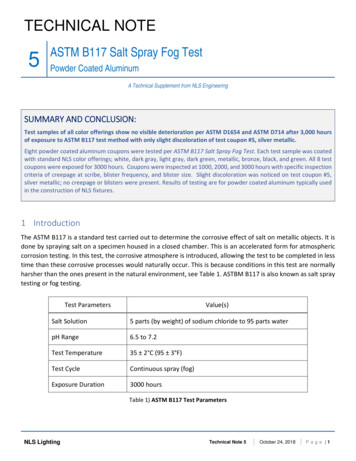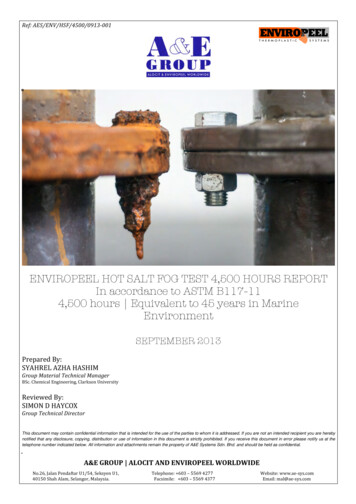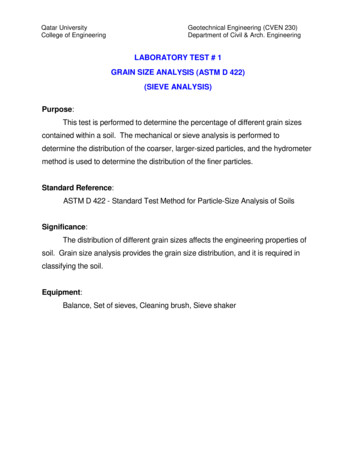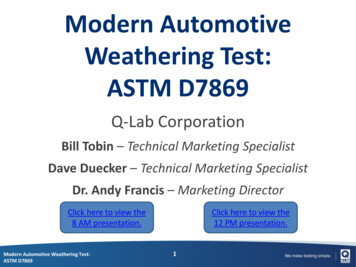
Transcription
Modern AutomotiveWeathering Test:ASTM D7869Q-Lab CorporationBill Tobin – Technical Marketing SpecialistDave Duecker – Technical Marketing SpecialistDr. Andy Francis – Marketing DirectorClick here to view the8 AM presentation.Modern Automotive Weathering Test:ASTM D7869Click here to view the12 PM presentation.1
Before we begin Slides will be provided in an email, followingthis webinar Use the Q&A feature at the bottomof the screen to ask question If you have any follow up questions after thepresentation, send them to info@q-lab.comModern Automotive Weathering Test:ASTM D78692
What is Weathering?Weathering: changes in material properties resultingfrom exposure to the radiant energy present in sunlight incombination with heat (including temperature cycling)and water in its various states, predominately ashumidity, dew, and rain.Modern Automotive Weathering Test:ASTM D78693
Why Do Weathering Testing?ORHigh gloss and color integrityFading, cracking, peelingWeathering testing can mean the difference between happycustomers and the customer on the rightModern Automotive Weathering Test:ASTM D78694
Why Do Weathering Testing?ORHigh gloss and color integrityGloss loss and color fadeWeathering testing can mean the difference between happycustomers and the customer on the rightModern Automotive Weathering Test:ASTM D78695
Qualification / Correlative TestingAccelerated TestTypeResultQuality ControlPass / failQualification /validationPass / failCorrelativeRank-ordered dataPredictiveModern Automotive Weathering Test:ASTM D7869Service lifeTest Time Defined Short Defined Medium-long Open-ended Medium Open-endedAcceleration factor Long6Results compared toMaterial specificationReference materialor specificationNatural exposure(Benchmark site)Natural exposure(Service environment)
Historical Xenon Test Standards Carbon Arc and Xenon arc weathering testing havebeen performed for over 100 years Xenon testers reproduce full-spectrum sunlight Hardware-based “102/18” light / light spraystandards were the first widely-used weatheringstandard tests– Almost 100 years old but still in use– Most common example is ISO 4892-2– Not realistic!Modern Automotive Weathering Test:ASTM D78697
Accelerated Weathering TestsCommonly Used on Automotive PartsInternational standardsAutomaker standards ASTM G154/G155 Renault D27-1911 ISO 4892-2, -3 VW PV 1303, PV 3929 SAE J2412 Daimler DBL 5555 SAE J2527 Fiat 50451 ASTM D7869 Ford BO 116 Toyota TSL 3600GMost are for QC/Qualification purposesModern Automotive Weathering Test:ASTM D78698
The Industry Standard: SAE J2527 SAE J2527 introduced in 1980’s– Authors researched light, water, heat– Test replicated gloss loss seen in Florida Standard was well-researched but did not match real-worldweathering factors– Light spectrum– Water delivery As a result, test does not always predict Florida outdoorfield failures– Chemical changes– Physical changesModern Automotive Weathering Test:ASTM D78699
Why Develop a New Standard?SAE J2527 was developed to reproduce commonfailures of coatings in that era, primarily colorfade and gloss loss.Over years, coatings became very resistant tocolor fade and gloss loss, and SAE J2527 doesn’treproduce more common failures in moderncoatings, primarily cracking and delamination.Modern Automotive Weathering Test:ASTM D786910
ASTM D7869:Modern Weathering TestingModern Automotive Weathering Test:ASTM D786911
Development Process Outdoor weather data collected to understand real-worldweather conditions: light, heat, and water Outdoor weathering test dataset collected to provide basis forcorrelation Accelerated test cycle developed to match those real-worldconditions and degradation mechanisms Variety of materials and failure modes evaluated withaccelerated testing to verify validity of testModern Automotive Weathering Test:ASTM D786912
Test Development Many years of experimentation– 1st group: BASF, Bayer, Ford, Q-Lab– 2nd group: Honda, Boeing, Atlas Dozens of different approaches Multiple runs of final test to ensurerepeatability & reproducibilityModern Automotive Weathering Test:ASTM D786913
Collecting outdoorweather dataLaying the groundwork for anew accelerated testModern Automotive Weathering Test:ASTM D786914
Outdoor weather dataApproach: collect outdoor weather data to betterunderstanding the forces of natural weathering: Sunlight Heat WaterGoal: Obtain suitable body of field data todevelop the Accelerated laboratory testModern Automotive Weathering Test:ASTM D786915
Outdoor WeatherData Collected Solar Radiation (Sunlight) Temperature– Air, Black Panel, Relative Humidity and Dew Point Wind– Speed and Direction Rain– Amount, Duration, Rate Accumulation Panel Weight– Wetness, Dew Events and Rain EventsModern Automotive Weathering Test:ASTM D786916
Outdoor Weather DataCollection Sites Weather Station Installed atBayer Site Jacksonville, FL– 2004 to 2007 Moved to Homestead, FL(Q-Lab)– 2008 to 2014Modern Automotive Weathering Test:ASTM D786917
Outdoor WeatherWater Data Measurements Mass of panel measuredevery 5 min– Panel Water Calibrated regularly Care taken to ensure noanimal or bird influence Able to see rain vs dew water-uptakeModern Automotive Weathering Test:ASTM D786918
Example from Outdoor DataWater on Test PanelsRainDewMaterials outdoors are wet forlonger than you think!Modern Automotive Weathering Test:ASTM D786919
Dew on Painted Panels2006 Dew Formation30CGrams Water on Panel2520BE1510D5AWind Noise06/30Day 1Modern Automotive Weathering Test:ASTM D78697/1Day 27/2Day 3207/3Day 47/4Day 57/5
Key Learnings fromOutdoor BenchmarkTestingModern Automotive Weathering Test:ASTM D786921
Key Factors in a CorrelativeWeathering Test Global benchmark location: South Florida Light intensity: use higher-intensity light with correctspectrum to increase acceleration Heat: Keep temperatures realistic, at or below service Time of wetness: Increase! Mimic real-world behavior panels wet 12 hrs/day in Florida Water spray: Never spray panels during light step; itnever rains when sun is shining brightly!Modern Automotive Weathering Test:ASTM D786922
Sunlight Explored different light sources Explored different optical filters Accelerated outdoor weathering(Q-TRAC) provided tantalizingresults Better match to sunlight just mightwork, but be careful Modern Automotive Weathering Test:ASTM D786923
The wrong light source gives thewrong results!Borosilicate filteredxenon odern Automotive Weathering Test:ASTM D786924
Accelerated Light Source Light source must have very good match to thesolar spectrum ASTM D7869 calls for a new optical filter– Daylight – F (Q-Lab)– Right Light (Atlas) Produces more realistic results– Higher irradiance– Better, more realistic accelerationModern Automotive Weathering Test:ASTM D786925
HeatHigh temperature serves primarily toaccelerate water uptake.Two key guiding principles:1. Do not exceed maximum servicetemperature2. Use realistic temperatures toincrease correlationModern Automotive Weathering Test:ASTM D786926
Water contributes to materialdegradation in many ways Plasticization Swelling Blistering Adhesion Mass transport Mass lossModern Automotive Weathering Test:ASTM D786927
Water Delivery Calibration: SpongeTest Determine actual water delivery tospecimens in both flat array & rotatingdrum testers Same sponge in both machines Results are Repeatable & ReproducibleModern Automotive Weathering Test:ASTM D786928
Sponge Water Calibration TestsRotating DrumFlat ArrayShielded sponge holderModern Automotive Weathering Test:ASTM D786929
Florida outdoor daily cycleLight IntensityPanel WaterContent02468101214Time (hours)Modern Automotive Weathering Test:ASTM D7869301618202224
IrradianceWater SprayASTM D7869Reproduces Natural Weather CyclesIrradiance (W/m2/nm @340nm)1.0Cyclic Stresses (cracking)Surface Erosion (gloss)Deep n0.70.60.50.4No spray duringlight 214Time (hours)Modern Automotive Weathering Test:ASTM D7869311618202224
Validating the testmethodPutting the ASTM D7869protocol to the testModern Automotive Weathering Test:ASTM D786932
Paint Systems TestedAutomotive 20 systems, multiple colors All systems were base coat / clear coat Fortified and unfortified Positive controls & known Florida exposure failure mechanismsAerospace Four systems, two colors (blue and white) Two monocoat systems, two base coat / clear coat systems Florida, and in-service performance knownModern Automotive Weathering Test:ASTM D786933
Outdoor TestingSample selection Sample set includes both commonfield failures & controls 106 Combinations Prepared– 4 colors: Black, White, Blue, Red– Waterborne & Solventborne Base– Solventborne Clear– Different layering systems– With and without Stabilizers All Samples prepared by one labModern Automotive Weathering Test:ASTM D786934
Outdoor TestingTest Protocol Testing conducted per SAE J1976 Evaluations every 6 months Exposure times Full Set Summer 2006 Partial Set Summer 2007 Expose Until FailureModern Automotive Weathering Test:ASTM D786935
Does This Test Reproduce AllCommon Failure Mechanisms? Chemical changes CrackingImportant to “test the test”and validate that thescientific approach tostandard development leadsto good correlation withnatural exposures Blistering Adhesion loss Color Gloss lossModern Automotive Weathering Test:ASTM D786936
Control SystemFlorida ExposureSAE J2527ASTM D7869Expected Failure Mode: None – positive controlObserved: Excellent performance in all testsModern Automotive Weathering Test:ASTM D786937
Coating Pick-OffFlorida ExposureJ2527ASTM D7869Expected Failure Mode: Slight BC/E-coat pick offObserved: Slight BC/E-coat pick-off ASTM D7869, not SAE J2527Modern Automotive Weathering Test:ASTM D786938
Gloss and Adhesion LossFlorida ExposureJ2527ASTM D7869 Expected Failure Mode: Blistering, gloss loss, adhesion lossObserved: Gloss and adhesion loss on both. Blistering ASTM D7869Modern Automotive Weathering Test:ASTM D786939
DelaminationFlorida ExposureJ2527ASTM D7869Expected Failure Mode: Blistering, gloss loss, adhesion lossObserved: Gloss and adhesion loss on both. Blistering ASTM D7869Modern Automotive Weathering Test:ASTM D786940
BlisteringFlorida ExposureSAE J2527ASTM D7869Expected Failure Mode: Blistering, gloss loss, adhesion lossObserved: Gloss loss and adhesion loss seen on all panels. Blistering onASTM D7869 mimics that seen on FloridaModern Automotive Weathering Test:ASTM D786941
Evaluate Validation TestingExample from ASTM D7869 Chemical changecorrectly reproduced Crackingcorrectly reproduced Blisteringcorrectly reproduced Adhesion losscorrectly reproduced Colorcorrectly reproduced Gloss losscorrectly reproducedModern Automotive Weathering Test:ASTM D786942
Conclusions: ASTM D7869 ASTM D7869 accelerated lab weathering test cycle is thoroughlyresearched - uses scientific understanding of outdoor weather – light,heat, and water Test cycle validated by comparing to long-term outdoor weathering dataof a variety of coatings systems ASTM D7869 is realistic - it reproduces faithfully almost all physical failuremechanisms and is 40% faster than current test method. Introduction of this new weathering protocol allows for more rapid andaccurate accelerated weathering results. These can be correlated withoutdoor test data to give powerful information.Modern Automotive Weathering Test:ASTM D786943
Thank you for your attention!Questions?info@q-lab.comModern Automotive Weathering Test:ASTM D786944
ASTM G154/G155 ISO 4892-2, -3 SAE J2412 SAE J2527 ASTM D7869 Automaker standards Renault D27-1911 VW PV 1303, PV 3929 Daimler DBL 5555 Fiat 50451 Ford BO 116 Toyota TSL 3600G Most are for QC/Qualification purposes. Modern Automotive Weathering Test: 9 ASTM D7869 The Industry Standard: SAE J2527 SAE J2527 introduced in 1980’s –Authors .


